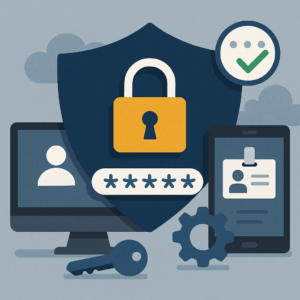Identity Management Solutions and Challenges for Businesses and Individuals
In an era where digital identities are paramount, understanding the intricacies of identity management and security is crucial for IT professionals and businesses alike. This article delves into the challenges of securing identities, and explores a range of innovative solutions tailored for both businesses and individuals. Equip yourself with the knowledge to navigate the complexities of identity access management and make informed decisions that bolster security in your organization.
Table of Contents
The Importance of Identity Management and Security

Defining Identity Management
Identity management (IM) is a comprehensive framework that encompasses the processes, policies, and technologies required to manage digital identities throughout their lifecycle. It involves the creation, maintenance, and deletion of user identities, ensuring that the right individuals have appropriate access to resources within an organization.
Key components of identity management systems include:
- User Provisioning: Automating the creation and management of user accounts.
- Access Management: Controlling user access to resources based on predefined policies.
- Identity Governance: Ensuring compliance with regulations and internal policies regarding identity access.
The role of identity access management in cybersecurity cannot be overstated. It serves as the first line of defense against unauthorized access, ensuring that only authenticated users can access sensitive information and systems.
The Growing Need for Identity Security
As digital threats and vulnerabilities continue to escalate, the need for robust identity security has never been more critical. Cybercriminals are increasingly targeting identities to gain unauthorized access to systems, leading to significant financial and reputational damage.
The impact of data breaches on businesses and individuals is profound. Organizations face hefty fines, loss of customer trust, and potential legal ramifications. For individuals, compromised identities can lead to identity theft and financial loss.
Regulatory compliance, such as GDPR and HIPAA, imposes strict requirements on how organizations manage identities. Failure to comply can result in severe penalties, making effective identity access management essential for both businesses and individuals.

Common Challenges in Identity Management and Security
Identifying and Mitigating Risks
Modern digital ecosystems face three major forces that amplify the importance of identity management and security:
- Escalating Threats:
Cybercriminals exploit stolen credentials through phishing, credential stuffing, and insider threats. Breaches not only result in financial loss but also erode customer trust and invite regulatory scrutiny. - Shadow IT and SaaS Sprawl:
Employees frequently sign up for tools like Canva, Trello, or other free trials using their work email—often without IT approval. These unsanctioned accounts can slip through the cracks of an organization’s IAM strategy, creating hidden attack surfaces. - Machine-to-Machine Identity Risk:
AI, automation, and API-driven services mean that machines are constantly communicating. Who authenticates these machines? Who audits API access? Without clear IAM policies, automated systems become prime targets for exploitation.
Balancing Security and User Experience
A significant challenge in identity access management is balancing stringent security measures with user experience. Overly complex authentication processes can frustrate users, leading to decreased productivity and potential workarounds that compromise security.
Strategies for enhancing user experience without compromising security include implementing single sign-on (SSO) solutions and adaptive authentication methods that adjust security requirements based on user behavior.
User education plays a crucial role in identity access management. By empowering users with knowledge about security best practices, organizations can foster a culture of security awareness that enhances overall identity security.

Best Practices for Businesses and Individuals
Implementing multifactor authentication (MFA) is one of the most effective ways to enhance identity security. By requiring multiple forms of verification, organizations can significantly reduce the risk of unauthorized access.
Regularly updating and auditing identity access management policies is essential to ensure that they remain effective in the face of evolving threats. Organizations should conduct periodic reviews to identify and address potential vulnerabilities.
Leveraging identity governance and administration (IGA) tools can streamline identity management processes, ensuring compliance and reducing the risk of human error.

Emerging Trends and Predictions
The future of IAM will be defined by:
- Automation in Identity Management: Detecting anomalies, automating access decisions, and monitoring machine-to-machine communications.
- Decentralized Identity Solutions: Shifting control of digital identities to individuals and secure devices.
- Hyper Secure Cloud Environments: Delivering security and compliance as an integrated service to support dynamic, cloud-first businesses.
As identity ecosystems expand to include users, devices, APIs, and AI agents, businesses must adopt continuous and automated IAM to stay ahead of threats.
Conclusion
The evolution of identity management technologies is expected to continue, with advancements in AI, biometrics, and decentralized solutions shaping the future landscape of identity security.
Anticipated challenges in the future include the increasing sophistication of cyber threats and the need for organizations to adapt to rapidly changing regulatory environments.
The importance of continuous adaptation and learning in identity management practices cannot be overstated. IT professionals must remain vigilant and proactive in their approach to identity security to safeguard their organizations against emerging threats.
Staying ahead of the curve is what we do; UberEther’s IAM Advantage platform delivers secure, scalable identity solutions in days, not months. Contact us today to learn more about how your organization’s security can become one of your greatest assets.




